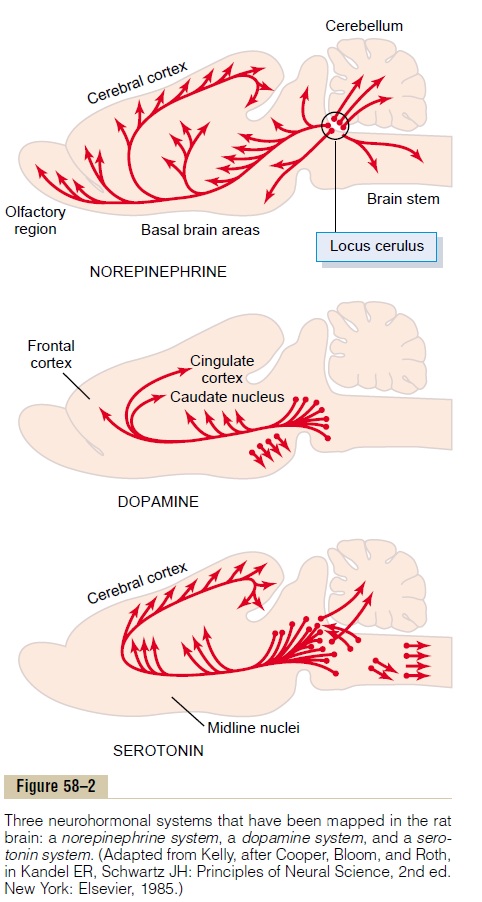Chapter: Medical Physiology: Behavioral and Motivational Mechanisms of the Brain-The Limbic System and the Hypothalamus
Neurohormonal Control of Brain Activity
Neurohormonal Control of Brain Activity
Aside from direct control of brain activity by specific transmission of nerve signals from the lower brain areas to the cortical regions of the brain, still another physiologic mechanism is very often used to control brain activity. This is to secrete excitatory orinhibitoryneurotransmitter hormonal agents into the substanceof the brain. These neurohormones often persist for minutes or hours and thereby provide long periods of control, rather than just instantaneous activation or inhibition.
Figure 58–2 shows three neurohormonal systems that have been mapped in detail in the rat brain: (1) a norepinephrine system, (2) adopamine system, and (3)a serotonin system. Norepinephrine usually functions

as an excitatory hormone, whereas serotonin usually is inhibitory, and dopamine is excitatory in some areas but inhibitory in others. As would be expected, these three systems have different effects on levels of excitability in different parts of the brain. The norepi-nephrine system spreads to virtually every area of the brain, whereas the serotonin and dopamine systems are directed much more to specific brain regions— the dopamine system mainly into the basal ganglial regions and the serotonin system more into the midline structures.
Neurohormonal Systems in the Human Brain. Figure 58–3shows the brain stem areas in the human brain for acti-vating four neurohormonal systems, the same three discussed for the rat and one other, the acetylcholinesystem. Some of the specific functions of these are asfollows:

1.The locus ceruleus and the norepinephrine system. The locus ceruleus is a small area located bilaterally and posteriorly at the juncture between the pons and mesencephalon. Nerve fibers from this area spread throughout the brain, the same as shown for the rat in the top frame of Figure 58–2, and they secrete norepinephrine. The norepinephrine generally excites the brain to increased activity. However, it has inhibitory effects in a few brain areas because of inhibitory receptors at certain neuronal synapses. We will see that this system probably plays an important role in causing dreaming, thus leading to a type of sleep called rapid eye movement sleep (REM sleep).
2.The substantia nigra and the dopamine system
It lies anteriorly in the superior mesencephalon, and its neurons send nerve endings mainly to the caudate nucleus and putamen of the cerebrum, where they secrete dopamine. Other neurons located in adjacentregions also secrete dopamine, but they send their endings into more ventral areas of the brain, especially to the hypothalamus and the limbic system. The dopamine is believed to act as an inhibitory transmitter in the basal ganglia, but in some other areas of the brain it is possibly excitatory. Also, remember that destruction of the dopaminergic neurons in the substantia nigra is the basic cause of Parkinson’s disease.
3.The raphe nuclei and the serotonin system. Inthe midline of the pons and medulla are several thin nuclei called the raphe nuclei. Many of the neurons in these nuclei secrete serotonin. They send fibers into the diencephalon and a few fibers to the cerebral cortex; still other fibers descend to the spinal cord. The serotonin secreted at the cord fiber endings has the ability to suppress pain. The serotonin released in the diencephalon and cerebrum almost certainly plays an essential inhibitory role to help cause normal sleep.
4.The gigantocellular neurons of the reticular excitatory area and the acetylcholine system.
Earlier we discussed the gigantocellular neurons (the giant cells) in the reticular excitatory area of the pons and mesencephalon. The fibers from these large cells divide immediately into two branches, one passing upward to the higher levels of the brain and the other passing downward through the reticulospinal tracts into the spinal cord. The neurohormone secreted at their terminals is acetylcholine. In most places, the acetylcholine functions as an excitatory neurotransmitter. Activation of these acetylcholine neurons leads to an acutely awake and excited nervous system.
Other Neurotransmitters and Neurohormonal Substances Secreted in the Brain. Without describing their function,the following is a list of still other neurohormonal substances that function either at specific synapses or by release into the fluids of the brain: enkephalins, gamma-aminobutyric acid, glutamate, vasopressin, adrenocorticotropic hormone, epinephrine, histamine, endorphins, angiotensin II, and neurotensin. Thus, there are multiple neurohormonal systems in the brain, the activation of each of which plays its own role in controlling a different quality of brain function.
Related Topics